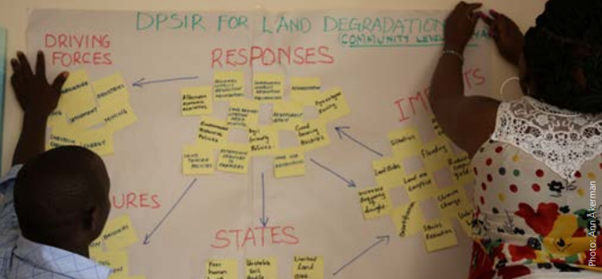In this 5-minute presentation (link to video below), Sara Gabrielsson, senior lecturer at LUCSUS, presents the DPSIR-framework with examples for each part. The framework was developed by the European Environment Agency and can be used to analyse causes and effects of environmental problems.
DPSIR stands for: Drivers, Pressures, State, Impacts and Responses:
- Drivers can come from different economic sectors or human activities that fulfill a need in our society. They can be identified on an individual level (e.g. food and entertainment) and a collective level (e.g. transportation and agriculture).
- These drivers cause pressure on the environment through various production or consumption processes. Examples of pressures include increased use of natural resources and land-use change such as deforestation.
- The pressure in turn affects the state of the environment. This state is a combination of all the physical, chemical, biological, and epidemiological conditions of a specific place and they include components that can be measured such as the quality of air, water or soil.
- The changes in the state of the environment impacts the functioning of ecosystems, with consequences for the system’s ecological sustainability, economic stability and social performance.
- To deal with these oftentimes undesired impacts policy makers or other societal actors can implement different types of responses directed towards any part of the chain between drivers to impacts, such as efforts to reduce emissions.
The DPSIR-framework could, inter alia, be used in workshops to kick start a discussion and data collection or be used as an analytical tool in theses or reflection papers. Given its process-oriented construction, it is one hands-on example of an activity that trains several sustainability competencies including systems-thinking and anticipatory-thinking (you can read more about sustainability competencies for instance in this paper by Redman & Wiek 2022: Frontiers | Competencies for Advancing Transformations Towards Sustainability).
The framework was developed to analyse environmental problems, but with some tweaking, perhaps it could be used for other types of sustainability problems. What do you think? Have you used this framework in your teaching? Let us know in the comments – it would be great to collect examples, experiences and hints and tips!
Watch Sara’s presentation here: Sara Gabrielsson: Analyzing human-environment interactions using DPSIR – YouTube
The presentation was developed as part of the course Universities and the Agenda 2030 – teaching, learning and acting on the Sustainable Development Goals. You can access the course as a self-study compendium here, with further videos, material and discussion questions: Universites and the Agenda 2030.pdf
Photo credit: Ann Åkerman

